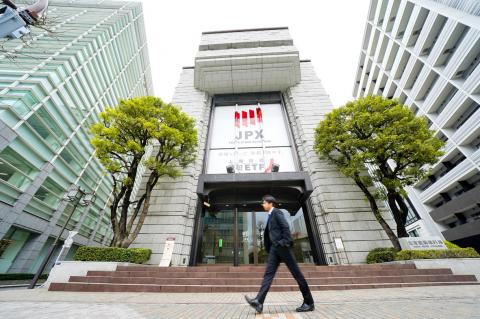As part of an effort to streamline markets and attract more investors, the Tokyo Stock Exchange (TSE) might demote about one-third of its largest listed companies and cut down the bourses it operates from four to three, local media reported on Friday.
A TSE advisory panel is expected to compile a report by the end of this month, after examining public comments on structural reforms for the US$5.7 trillion equity market.
The reported changes would demote hundreds of companies from the TSE’s First Section, investors said.

Photo: Bloomberg
The exchange included 2,137 companies as of Thursday — double the number in 1990, the exchange’s parent, Japan Exchange Group Inc, said.
“It’s good to reduce the number of companies in the TSE’s First Section,” said Kazuyuki Terao, the chief investment officer of Allianz Global Investors’ Japanese unit. “A lot of investors are using the TOPIX as a benchmark for their investments and the number of the constituents in the TOPIX is too many.”
The TSE might raise the minimum market-cap requirement to remain listed on the First Section to ¥25 billion (US$224 million) from ¥2 billion, and require companies disclose filings in English, the Nikkei Shimbun said on Friday.
Kyodo News reported the panel plans to recommend reducing the number of exchanges.
Japan Exchange Group spokesman Satoshi Mimura said that no decision has been made.
About half of the TOPIX’s members have market values below ¥50 billion.
If the ¥25 billion market cap threshold were to be implemented, it would cut the first board to a little more than 1,400 companies, according to data compiled by Bloomberg.
The panel is proposing categorizing TSE stocks into three sections — premium, standard and emerging, according to the Mainichi Shimbun , which did not say where it got the information.
The TSE has the First and Second Sections, the Mothers and Jasdaq start-up exchanges.
Companies on the First Section that are near the market cap threshold might seek mergers and acquisitions or management buyouts, Masahiro Suzuki, an analyst at Daiwa Securities Group Inc, wrote in a note on Friday.
Some investors saw the reported changes as unwelcome.
Masakazu Hosomizu, a Chicago-based portfolio manager at RMB Capital, said splitting the First Section by market cap would “fundamentally alter the constituents of the TOPIX” and “force a massive sell-off by passive investors due to their portfolio rebalancing requirement.”
Yoshinori Shigemi, a Tokyo-based global market strategist at JPMorgan Asset Management, said screening companies just by their market cap is not desirable.

WEAKER ACTIVITY: The sharpest deterioration was seen in the electronics and optical components sector, with the production index falling 13.2 points to 44.5 Taiwan’s manufacturing sector last month contracted for a second consecutive month, with the purchasing managers’ index (PMI) slipping to 48, reflecting ongoing caution over trade uncertainties, the Chung-Hua Institution for Economic Research (CIER, 中華經濟研究院) said yesterday. The decline reflects growing caution among companies amid uncertainty surrounding US tariffs, semiconductor duties and automotive import levies, and it is also likely linked to fading front-loading activity, CIER president Lien Hsien-ming (連賢明) said. “Some clients have started shifting orders to Southeast Asian countries where tariff regimes are already clear,” Lien told a news conference. Firms across the supply chain are also lowering stock levels to mitigate

Six Taiwanese companies, including contract chipmaker Taiwan Semiconductor Manufacturing Co (TSMC, 台積電), made the 2025 Fortune Global 500 list of the world’s largest firms by revenue. In a report published by New York-based Fortune magazine on Tuesday, Hon Hai Precision Industry Co (鴻海精密), also known as Foxconn Technology Group (富士康科技集團), ranked highest among Taiwanese firms, placing 28th with revenue of US$213.69 billion. Up 60 spots from last year, TSMC rose to No. 126 with US$90.16 billion in revenue, followed by Quanta Computer Inc (廣達) at 348th, Pegatron Corp (和碩) at 461st, CPC Corp, Taiwan (台灣中油) at 494th and Wistron Corp (緯創) at

NEW PRODUCTS: MediaTek plans to roll out new products this quarter, including a flagship mobile phone chip and a GB10 chip that it is codeveloping with Nvidia Corp MediaTek Inc (聯發科) yesterday projected that revenue this quarter would dip by 7 to 13 percent to between NT$130.1 billion and NT$140 billion (US$4.38 billion and US$4.71 billion), compared with NT$150.37 billion last quarter, which it attributed to subdued front-loading demand and unfavorable foreign exchange rates. The Hsinchu-based chip designer said that the forecast factored in the negative effects of an estimated 6 percent appreciation of the New Taiwan dollar against the greenback. “As some demand has been pulled into the first half of the year and resulted in a different quarterly pattern, we expect the third quarter revenue to decline sequentially,”

ASE Technology Holding Co (ASE, 日月光投控), the world’s biggest chip assembly and testing service provider, yesterday said it would boost equipment capital expenditure by up to 16 percent for this year to cope with strong customer demand for artificial intelligence (AI) applications. Aside from AI, a growing demand for semiconductors used in the automotive and industrial sectors is to drive ASE’s capacity next year, the Kaohsiung-based company said. “We do see the disparity between AI and other general sectors, and that pretty much aligns the scenario in the first half of this year,” ASE chief operating officer Tien Wu (吳田玉) told an